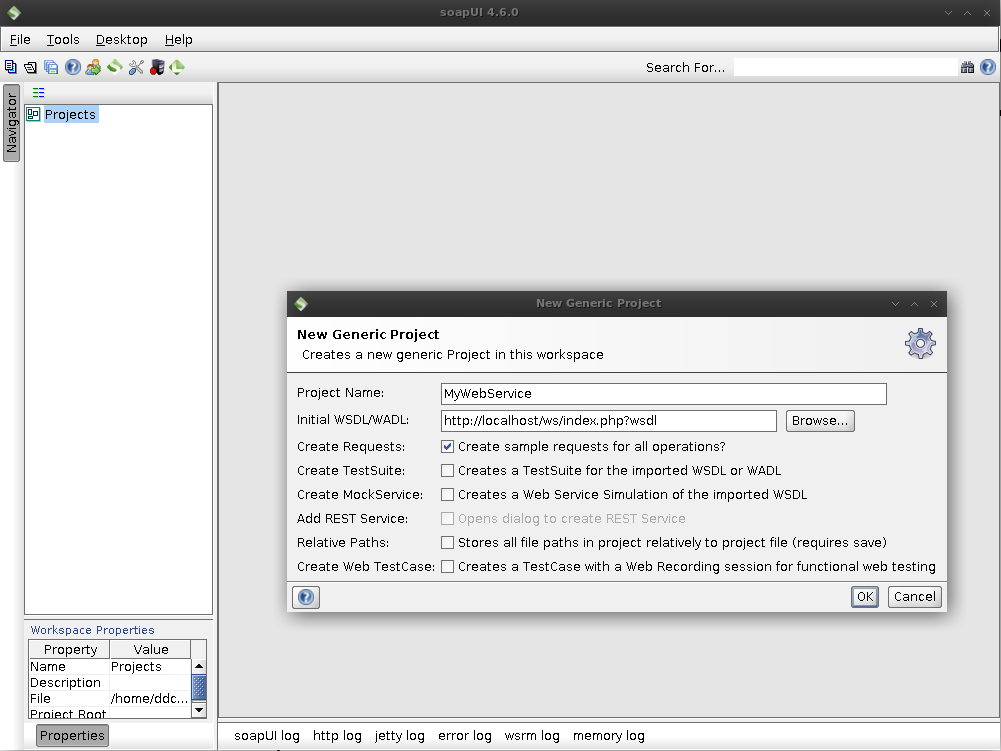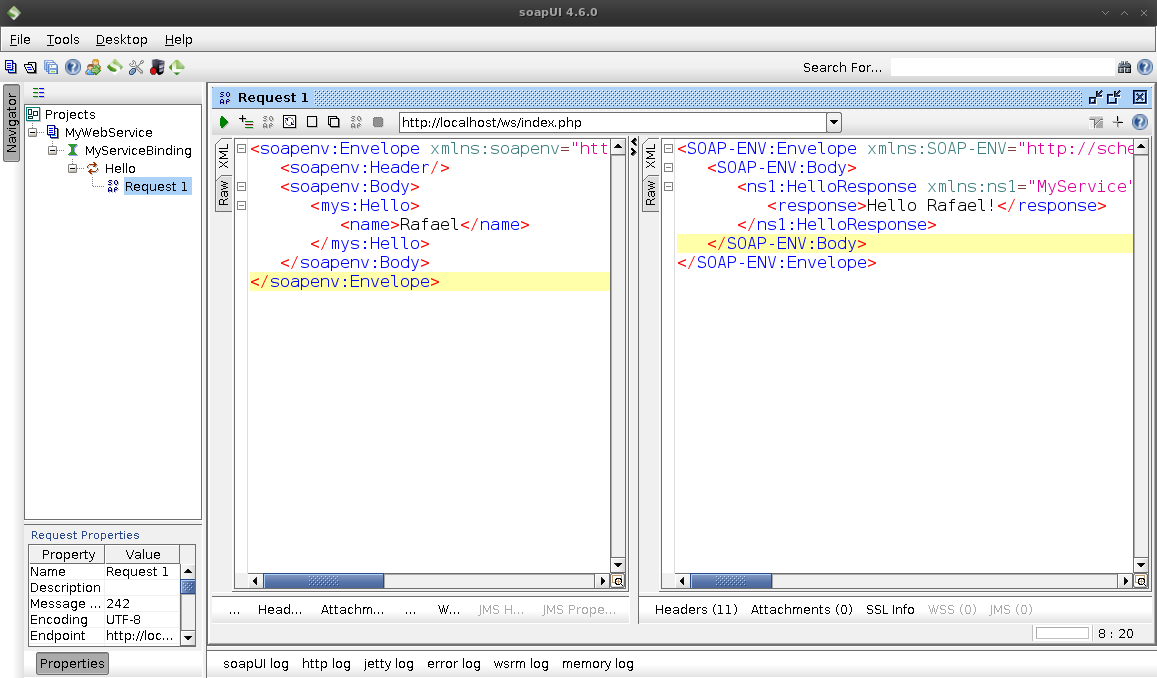Testing a Web service
I’ve been working with Web services these days for some college projects. Here are some interesting ways to test your web service.
Supponse this is our Web service:
<?php
require_once 'lib/nusoap.php';
function Hello($name)
{
return "Hello " . $name . "!";
}
$server = new soap_server();
$server->configureWSDL("MyService", "urn:MyService");
$server->soap_defencoding = 'utf-8';
$server->register('Hello',
array('name' => 'xsd:string'),
array('response' => 'xsd:string'),
'MyService',
false,
'rpc',
'literal',
'Test method.'
);
if (isset($HTTP_RAW_POST_DATA)) {
$server->service($HTTP_RAW_POST_DATA);
} else {
$server->service("php://input");
}
?>
Now, how to test if our Web service is working as expected? Let’ see.
SoapUI
This is a greate tool. Given a Web service location, SoapUI generates the needed SOAP messages to send requests to our Web service. Here I show how to test our previous Web service.


Command line
Using the command line always let us understand better how the stuffs works :).
Put the following request message in a file called request.xml:
<soapenv:Envelope xmlns:soapenv="http://schemas.xmlsoap.org/soap/envelope/" xmlns:mys="MyService">
<soapenv:Header/>
<soapenv:Body>
<mys:Hello>
<name>Rafael</name>
</mys:Hello>
</soapenv:Body>
</soapenv:Envelope>Using Wget
Issue the following command to test our Web service:
wget --post-file=request.xml --header="Content-Type: text/xml" --header="SOAPAction: 'Hello'" http://localhost/ws/index.php?wsdl -O response.xmlThe content the file response.xml should be something like this:
<?xml version="1.0" encoding="utf-8"?><SOAP-ENV:Envelope xmlns:SOAP-ENV="http://schemas.xmlsoap.org/soap/envelope/" xmlns:xsd="http://www.w3.org/2001/XMLSchema" xmlns:xsi="http://www.w3.org/2001/XMLSchema-instance" xmlns:SOAP-ENC="http://schemas.xmlsoap.org/soap/encoding/"><SOAP-ENV:Body><ns1:HelloResponse xmlns:ns1="MyService"><response>Hello Rafael!</response></ns1:HelloResponse></SOAP-ENV:Body></SOAP-ENV:Envelope>This is the same response shown in picture , unindented though.
Using cURL
Here is the curl version:
curl --header "Content-Type: text/xml; charset=utf-8" --data @request.xml http://localhost/ws/index.php > out.xmlThe content of the out.xml file must be the same as the previous example.
Using telnet
Here I show you how you can send an HTTP POST request to our WS using telnet:
[10:29:57]ddc@intel~$ telnet localhost 80
Trying ::1...
Connected to localhost.
Escape character is '^]'.
POST /ws/index.php HTTP/1.0
Content-Type: text/xml; charset=utf-8
Content-Length: 212
<soapenv:Envelope xmlns:soapenv="http://schemas.xmlsoap.org/soap/envelope/" xmlns:mys="MyService"> <soapenv:Header/> <soapenv:Body> <mys:Hello> <name>Rafael</name> </mys:Hello> </soapenv:Body> </soapenv:Envelope>
HTTP/1.1 200 OK
Date: Wed, 20 Nov 2013 16:29:59 GMT
Server: Apache/2.2.22 (Debian)
X-Powered-By: PHP/5.4.4-14+deb7u4
X-SOAP-Server: NuSOAP/0.9.5 (1.123)
Content-Length: 420
Vary: Accept-Encoding
Connection: close
Content-Type: text/xml; charset=utf-8
<?xml version="1.0" encoding="utf-8"?><SOAP-ENV:Envelope xmlns:SOAP-ENV="http://schemas.xmlsoap.org/soap/envelope/" xmlns:xsd="http://www.w3.org/2001/XMLSchema" xmlns:xsi="http://www.w3.org/2001/XMLSchema-instance" xmlns:SOAP-ENC="http://schemas.xmlsoap.org/soap/encoding/"><SOAP-ENV:Body><ns1:HelloResponse xmlns:ns1="MyService"><response>Hello Rafael!</response></ns1:HelloResponse></SOAP-ENV:Body></SOAP-ENV:Envelope>Connection closed by foreign host.DON’T FORGET to specify the content length!
Using Java
Well, this is useful too, specially if you are developing a Java application.
import java.io.BufferedReader;
import java.io.DataOutputStream;
import java.io.InputStreamReader;
import java.net.HttpURLConnection;
import java.net.URL;
import java.net.HttpURLConnection;
public class TestWS {
public static void main(String[] args) throws Exception {
TestWS test = new TestWS();
test.test();
}
private void test() throws Exception {
String ws = "http://localhost/ws/index.php";
URL url = new URL(ws);
HttpURLConnection conn = (HttpURLConnection) url.openConnection();
conn.setRequestMethod("POST");
conn.setRequestProperty("Content-Type:", "text/xml");
//conn.setRequestProperty("Header", "SOAPAction: 'Hello'");
String message = "<soapenv:Envelope xmlns:soapenv='http://schemas.xmlsoap.org/soap/envelope/' xmlns:mys='MyService'> <soapenv:Header/> <soapenv:Body> <mys:Hello> <name>Rafael</name> </mys:Hello> </soapenv:Body> </soapenv:Envelope>";
conn.setDoOutput(true);
DataOutputStream out = new DataOutputStream(conn.getOutputStream());
out.writeBytes(message);
out.flush();
out.close();
BufferedReader in = new BufferedReader(
new InputStreamReader(conn.getInputStream())
);
String line, response = "";
while ((line = in.readLine()) != null)
response += line;
in.close();
System.out.println(response);
}
}Using C++ with Qt
I used this too:
MainWindow::MainWindow(QWidget *parent) :
QMainWindow(parent),
ui(new Ui::MainWindow)
{
ui->setupUi(this);
QVBoxLayout *layout = new QVBoxLayout();
QPushButton *testButton = new QPushButton("Test service");
connect(testButton, SIGNAL(clicked()), this, SLOT(testService()));
layout->addWidget(testButton);
QWidget *widget = new QWidget(this);
widget->setLayout(layout);
setCentralWidget(widget);
}
MainWindow::~MainWindow()
{
delete ui;
}
void MainWindow::testService()
{
QString message("<soapenv:Envelope xmlns:soapenv='http://schemas.xmlsoap.org/soap/envelope/' xmlns:mys='MyService'> <soapenv:Header/> <soapenv:Body> <mys:Hello> <name>Rafael</name> </mys:Hello> </soapenv:Body> </soapenv:Envelope>");
QUrl url("http://localhost/ws/index.php");
QNetworkRequest request(url);
request.setHeader(QNetworkRequest::ContentTypeHeader, "text/xml");
QNetworkAccessManager *nm = new QNetworkAccessManager(this);
QObject::connect(nm, SIGNAL(finished(QNetworkReply *)), this, SLOT(testFinished(QNetworkReply*)));
nm->post(request, message.toAscii());
}
void MainWindow::testFinished(QNetworkReply *reply)
{
QByteArray ans = reply->readAll();
QString response(ans.data());
// Process your response message
qDebug() << response << endl;
}The methods testService() and testFinished() are SLOTS.
What’s next?
So far we have seen only how to test the connection to the Web service, the next step would be to extract the information we need from the response message, is not that hard, search for XML parser for your language, for Qt I’ve used QXmlStreamReader.
I hope this be helpful.